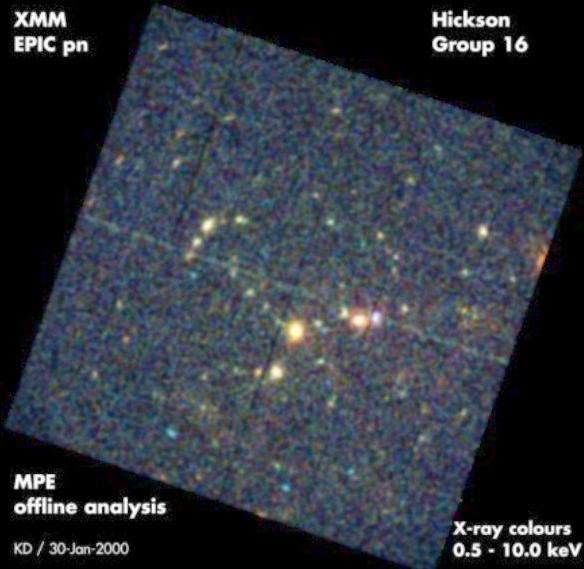
 Credit: ESA
Credit: ESA
Compact Group Controversy
"Compact groups" of galaxies are isolated regions of space where the
apparent density of galaxies is especially high. The word "apparent" is
important, since it's not clear if the galaxies in these groups are
physically related or if they simply represent chance superpositions of
unrelated galaxies which happen to lie along the same line of sight. X-ray
observations can help resolve this issue by looking for telltale traces of
hot gas existing between the galaxies. If the galaxies in the group are
physically related, there should be a significant amount of diffuse
emission from this hot gas; if they are unrelated, there should be
relatively little hot gas. This X-ray test can only be accomplished with an
X-ray telescope which is sensitive to faint, low surface brightness
emission; which is sensitive to low-energy X-ray emission; and which has
good spatial resolution (to distinguish the emission from the member
galaxies from the diffuse emission). The XMM-Newton observatory provides
astronomers with such a telescope. The image above was taken by the EPIC-PN CCD
camera on XMM-Newton, and shows a first look at one important compact group
called HCG 16 (for "Hickson compact group"). The image above shows a "true
color" image, in which the color of the emission represents the temperature
of the X-ray emitting gas. Additional observations like this one will
probably resolve the compact group controversy.
Last Week *
HEA Dictionary * Archive
* Search HEAPOW
* Education
Each week the HEASARC
brings you new, exciting and beautiful images from X-ray and Gamma ray
astronomy. Check back each week and be sure to check out the HEAPOW archive!
Page Author: Dr. Michael F.
Corcoran
Last modified September 15, 2000


